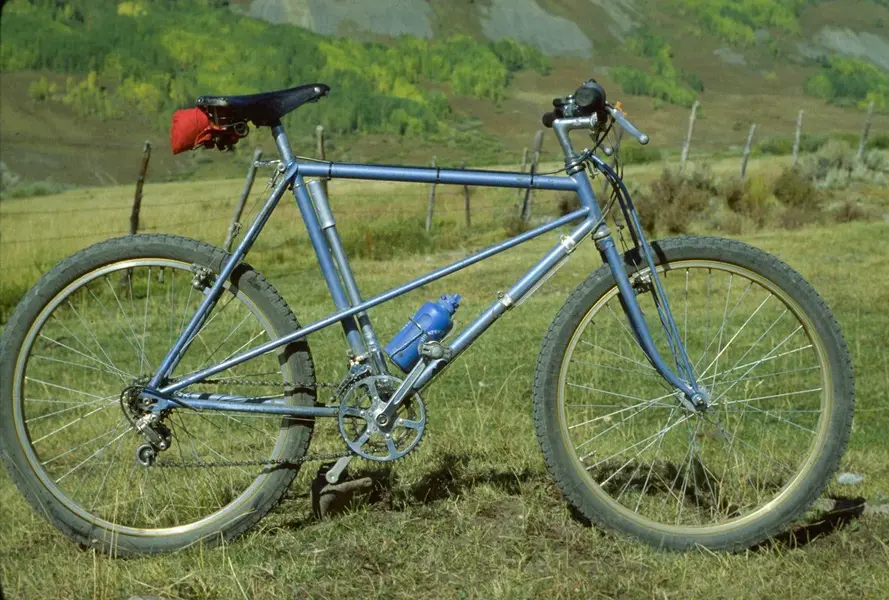You are using an out of date browser. It may not display this or other websites correctly.
You should upgrade or use an alternative browser.
You should upgrade or use an alternative browser.
Oldest mountain bike in UK?
- Thread starter 2manyoranges
- Start date
- Feedback
- View
Re:
As promised some evidence as to key dates for Geoff Apps' first custom built bikes:
In 1977 a nationwide competition to design a bicycle of the future was launched. It was sponsored by the Sunday Times & British Cycling Bureau as representatives of the cycle trade). The competition was open to anyone as long as they provided at least one drawing of their design. The closing date for entry was 29/12/1978.
The entries for this competition included designs for Tracker style bikes.
In April 1979 the results were published.
So in light of the BMX cycling boom and the Mountain bike boom that happened a decade later how well did the entrants do in correctly predicting the future? Fairly well it seems. The judge’s report says: “The entries included a lot of machines looking much like one-person-powered scramble motorcycles”. What this range of designs looked like we may never know as the distinguished judges clearly thought that the future was to be about folding bikes and so ignored the off-road entries.
This is the cover of the magazine where Apps first heard about Nokia Hakkapeliitta tyres. His earlier Bike of the Future entry shows fat tyres similar to those used on trials motorbikes.
Below is what claims to be the first magazine article to feature custom built Geoff Apps bicycles fitted with Hakkapeliitta tyres. The article does not show the date of publishing however it says that Apps hopes to show the bikes at the NEC and Harrogate in 1981 giving the impression that it was written earlier than 1981, probably in 1980. It mentions meeting Apps in the Lake District in October, implying that the bikes were photographed in October 1980.
As promised some evidence as to key dates for Geoff Apps' first custom built bikes:
In 1977 a nationwide competition to design a bicycle of the future was launched. It was sponsored by the Sunday Times & British Cycling Bureau as representatives of the cycle trade). The competition was open to anyone as long as they provided at least one drawing of their design. The closing date for entry was 29/12/1978.
The entries for this competition included designs for Tracker style bikes.
In April 1979 the results were published.
So in light of the BMX cycling boom and the Mountain bike boom that happened a decade later how well did the entrants do in correctly predicting the future? Fairly well it seems. The judge’s report says: “The entries included a lot of machines looking much like one-person-powered scramble motorcycles”. What this range of designs looked like we may never know as the distinguished judges clearly thought that the future was to be about folding bikes and so ignored the off-road entries.
This is the cover of the magazine where Apps first heard about Nokia Hakkapeliitta tyres. His earlier Bike of the Future entry shows fat tyres similar to those used on trials motorbikes.
Below is what claims to be the first magazine article to feature custom built Geoff Apps bicycles fitted with Hakkapeliitta tyres. The article does not show the date of publishing however it says that Apps hopes to show the bikes at the NEC and Harrogate in 1981 giving the impression that it was written earlier than 1981, probably in 1980. It mentions meeting Apps in the Lake District in October, implying that the bikes were photographed in October 1980.
Attachments
-
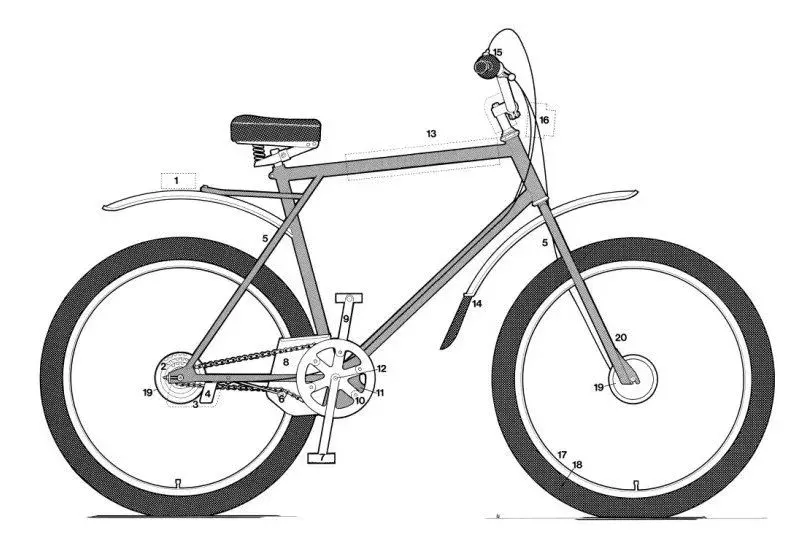 Geoff Apps 1977.webp44.9 KB · Views: 365
Geoff Apps 1977.webp44.9 KB · Views: 365 -
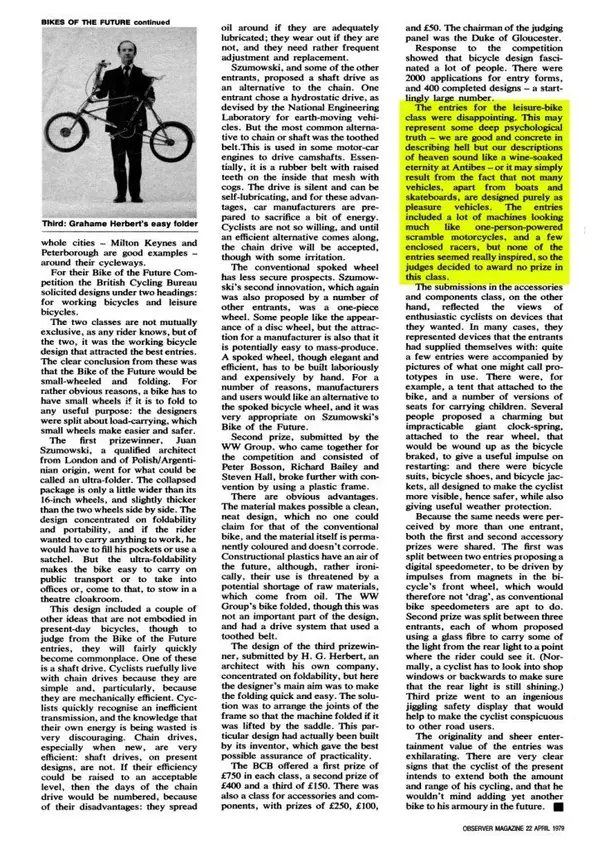 ReportPageThreeC.webp221.2 KB · Views: 365
ReportPageThreeC.webp221.2 KB · Views: 365 -
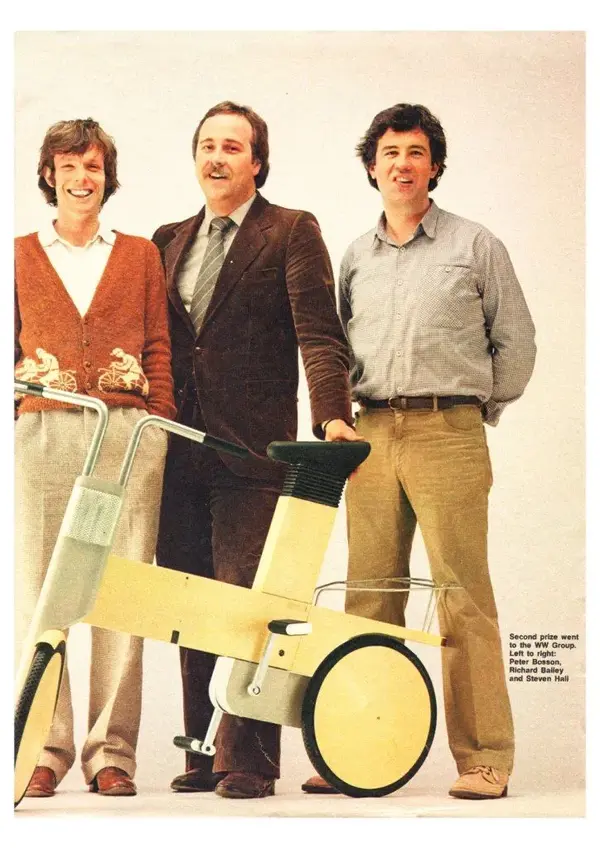 ReportPageTwoC.webp97.5 KB · Views: 364
ReportPageTwoC.webp97.5 KB · Views: 364 -
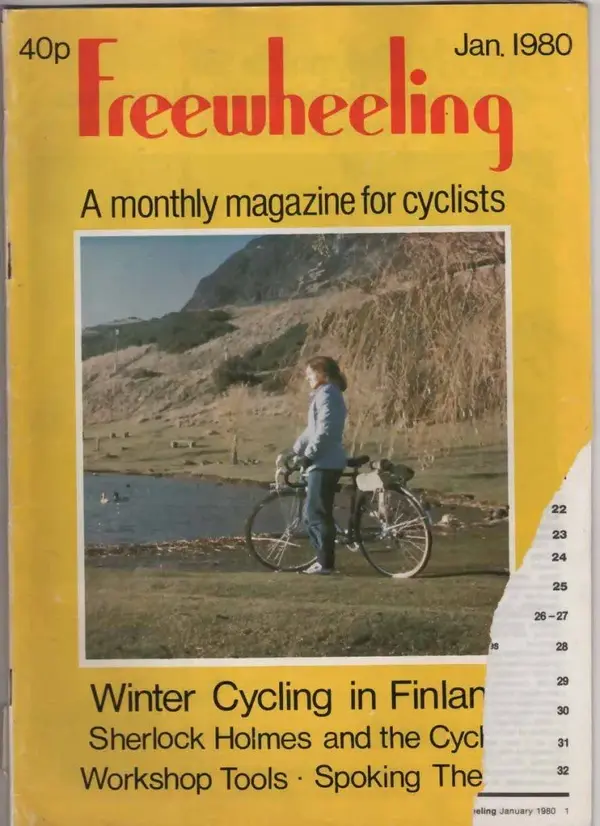 Hakkapeliitta001c.webp74.2 KB · Views: 365
Hakkapeliitta001c.webp74.2 KB · Views: 365 -
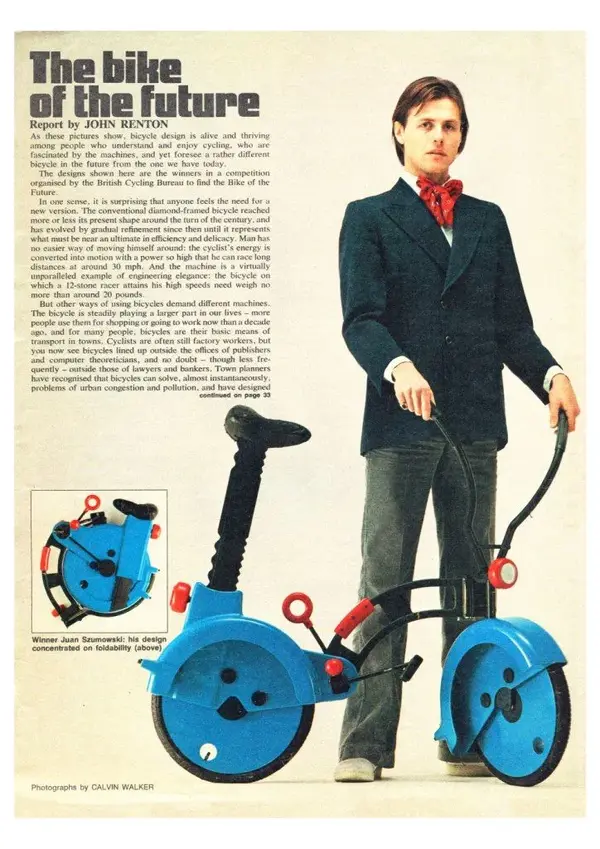 ReportPageOneC.webp107.2 KB · Views: 369
ReportPageOneC.webp107.2 KB · Views: 369 -
 Early Magazine Article.webp166.5 KB · Views: 370
Early Magazine Article.webp166.5 KB · Views: 370 -
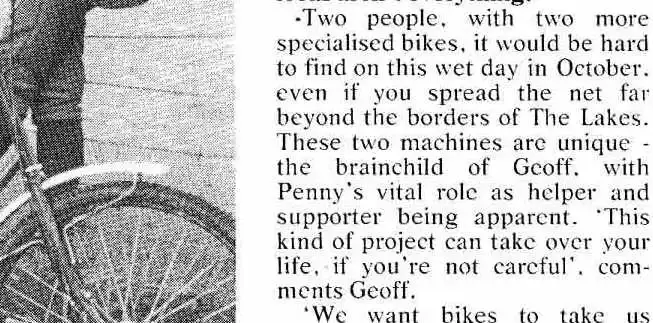 Early Magazine Article detail.webp53.6 KB · Views: 368
Early Magazine Article detail.webp53.6 KB · Views: 368 -
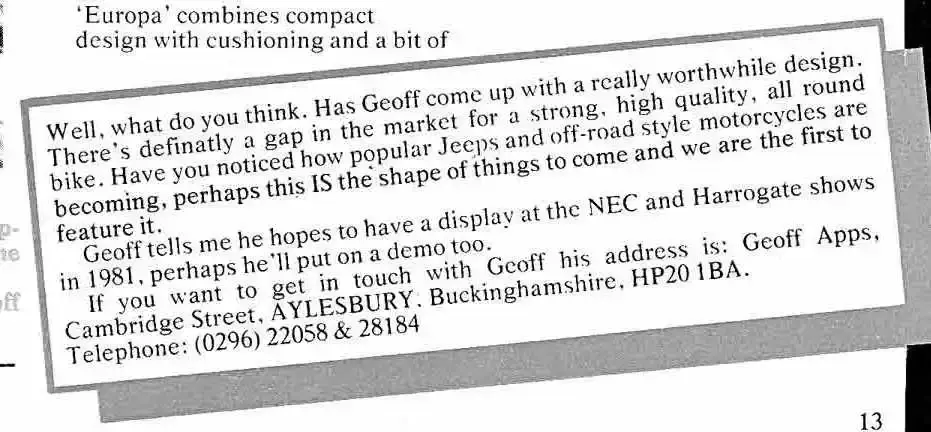 First Magazine Article detail.webp47.3 KB · Views: 365
First Magazine Article detail.webp47.3 KB · Views: 365
From the racks of them i see round here they seem to come in a few versions. Almost all of them have the holes for studs, but you can get multiple patterns of studs (or no studs), varying from two rings round the shoulder of the tyre for road use (deflate slighty for icy conditions), ~50% filled holes for general use, ~100% fill for ice riding. They also come in a fairly soft compound (high silica content) to keep traction and flexibility at low temps. Nearest thing i can compare it to is the sort of rubber you get on a very high end soft compound DH tyre. Once it's -20 (the coldest i've been out in) they behave like normal tyres.GrahamJohnWallace":1g6kn9c0 said:Woz":1g6kn9c0 said:Graham, do you have a decent picture of the Nokian Hakkapeliitta from that period?
What I'm curious about is to what degree these tyres were sufficiently knobbly and if they
had metal studs and Apps removed them?
Hi Woz, I have a collection of Hakkapeliitta tyres from over the years. The only difference between them is the brand name changing from Nokia to Nokian and then Suomi and that some have tungsten carbide ice studs and some earlier versions were supplied with stud holes but no studs fitted.
By comparison, even now, most of the competition seem to use a standard (or even a cheap) compound rubber that means they are basically shit, heavy tyres with studs in, a horror to actually ride anywhere. The Nokians are actually quite decent tyres, with studs (i'm running a set tubeless on my winter bike).
Yeah, not light, even the current racy ones are ~800 grams. The heavy tubes may have been a side effect of the original spec of the bike, you don't want troops having to stop and change tubes, ever. Old swedish army bikes are actually quite sought after for commuting round here.......GrahamJohnWallace":1g6kn9c0 said:They were intended to work at -40 degrees Celsius and came with heavy innertubes that were as wide as the tyre even when uninflated. On the downside each tyre and innertube weighed 3lbs.
The combination of headangle/fork rake/trail is going to make an even bigger difference than the tyre pressure/rim width. I'm running 2.35" on 17mm wide rims at 12-14 psi with a fairly modern geo frame and that needs some significant force to turn at low speeds. That also makes it far more stable at speed.GrahamJohnWallace":22zwmn1w said:Earlier Clelands mostly used very wide motor-cross or motorcycle trials handlebars. Over time these got cut down as it was found that you didn't need that much leverage to control a 54mm wide front tyre running on narrow rims at 10psi. Even faced with a pile of house bricks the tyre just snakes around them with remarkably little kickback. On one occasion I demonstrated this by cycling up a heap of builders rubble, did a U-turn on the top and then came down the along same route I had ascended. Something that would wreck the sidewalls of lesser tyres and be an impossible manoeuvre when using high tyre pressures.
Anyhow in Geoff's proving grounds of the Chiltern forests there are lots of closely planted trees and so wide handlebars just aren't practical. Also In summer when the nettles are tall, high handlebars are a very practical idea.
mrkawasaki
Retrobike Rider
Yet more fabulous intell - thanks all.
That BoF entry is without doubt a 'mountain bike' circa 1991 template with a very BMX'y feel. Maybe that was a compromise to engage the cycling fashions of the day? Imagine if that had been licensed to say Alpinestars...
If we look at the design of the first Joe Breeze custom off road bike, we see much less of what is often ascribed as a true 'mountain bike' around here.
It's rather too easy to fall into a revisionists' take on what a mountain bike is and isn't, based on our own introductions and involvements with typical Bristish MTB racing (as much as 13-15 years on from these designs!). The individuals working away on their own weren't aiming for cycling world domination, they were merely trying to satisfy their own local needs, having recognised that an off the peg solution did not exist for them.
What is genuinely fascinating to me is, in those pre-internet days, who was talking to who and what was being shared. Getting several of these homebrew innovators thinking and working together (albeit remotely) is when things take off and a more generalised, sophisticated and improved product evolves.
Did Geoff Apps send or receive any images or drawings of what Joe and Tom were making and/or did he send any of his designs their way at that time?
That BoF entry is without doubt a 'mountain bike' circa 1991 template with a very BMX'y feel. Maybe that was a compromise to engage the cycling fashions of the day? Imagine if that had been licensed to say Alpinestars...
If we look at the design of the first Joe Breeze custom off road bike, we see much less of what is often ascribed as a true 'mountain bike' around here.
It's rather too easy to fall into a revisionists' take on what a mountain bike is and isn't, based on our own introductions and involvements with typical Bristish MTB racing (as much as 13-15 years on from these designs!). The individuals working away on their own weren't aiming for cycling world domination, they were merely trying to satisfy their own local needs, having recognised that an off the peg solution did not exist for them.
What is genuinely fascinating to me is, in those pre-internet days, who was talking to who and what was being shared. Getting several of these homebrew innovators thinking and working together (albeit remotely) is when things take off and a more generalised, sophisticated and improved product evolves.
Did Geoff Apps send or receive any images or drawings of what Joe and Tom were making and/or did he send any of his designs their way at that time?
Attachments
- Feedback
- View
Can someone re name this thread ‘a homage to tweed’ as it’s now a thread about Jeff
Otherwise can we get back on topic- the pic in in the link below is a lot earlier than Jeff and it contains a bike with mud on it !
Or do we owe everything to Jeff
viewtopic.php?f=1&t=393943&p=2912079#p2912061
Otherwise can we get back on topic- the pic in in the link below is a lot earlier than Jeff and it contains a bike with mud on it !
Or do we owe everything to Jeff
viewtopic.php?f=1&t=393943&p=2912079#p2912061
- Feedback
- View
Retro Spud":1tec4nnv said:Can someone re name this thread ‘a homage to tweed’ as it’s now a thread about Jeff
Otherwise can we get back on topic- the pic in in the link below is a lot earlier than Jeff and it contains a bike with mud on it !
Or do we owe everything to Jeff
viewtopic.php?f=1&t=393943&p=2912079#p2912061
If you asked Gary Fisher, Joe Breeze or Charlie Kelly who made the first mountain bikes in the UK? they would point you towards Geoff, not Jeff, Apps. This is because he was the first British person they associated with designing and building mountain bikes and with who they frequently corresponded with between 1980 and 1984. He also had articles and adverts for his bikes published in the 'Fat Tire Flyer' magazine.
They would think it strange if he were not included in a thread discussing the 'Oldest mountin bike in UK?'
- Feedback
- View
Re:
Graham
You’ve always been open about Geoff and his safety bike being just one part of evolution and to your credit made a point of this - but we’ve fixated on just him and stagnated - he wasn’t alone in the design competition that never was, that you mention on an earlier page but I’m not hearing their contribution being discussed or acknowledged.
My point in question if the pic of Mr Crud in the link above is truly from the 1970’s what the hell is he sat on ?
And can we widen the topic back out ?
I’m not knocking Geoff but the quote below attributed to Gary Fisher sums up the evolution better than I can
Graham
You’ve always been open about Geoff and his safety bike being just one part of evolution and to your credit made a point of this - but we’ve fixated on just him and stagnated - he wasn’t alone in the design competition that never was, that you mention on an earlier page but I’m not hearing their contribution being discussed or acknowledged.
My point in question if the pic of Mr Crud in the link above is truly from the 1970’s what the hell is he sat on ?
And can we widen the topic back out ?
I’m not knocking Geoff but the quote below attributed to Gary Fisher sums up the evolution better than I can
Attachments
- Feedback
- View
Re: Re:
viewtopic.php?f=1&t=334891
Geoff Apps and I suspect the other 'Bike of the Future' "one man powered scramble motorbike enthusiasts" belonged to this tradition.
Including 'Tracker' bikes in that list opens up a can of worms as the US had its own 'Tracker' bike tradition that appears to have been preceeded by the UK traddition. This raises the question as to which is/was the oldest 'tracker bike' in the US.
Investigating US rough-stuff traditions gets equally confusing as US pioneers John Finley-Scott, Gary Fisher, Charlie Kelly were all members of the British Roughstuff Fellowship. Whilst Tom Ritchey was into rough-stuff riding before he ever saw Breezer No.1 let alone built a mountain-bike.
This is how, in my own head, I subdivide off-road bicycles. This may prove helpful in framing the debate:
1/ Road bicycles ridden over rough terrain. (These are not mountain-bikes)
2/ Road bicycles with basic modifications to improve their rough terrain abbilities like 'Trackers' & 'Klunkers' (These are not true mountain-bikes but possibly an evolutionary stage towards them)
3/ Poorly made (usually relatively inexpensive) bikes specifically designed for riding over rough terrain. (Raleigh Bomber and similar US made bikes) (These are not true mountain-bikes but possibly a transitional stage towards them)
4/Well made (often expensive and relatively lightweight) bikes specifically designed for riding over rough terrain and utilising customised frames and components. (These are all mountain bikes irrespective of what other names might be attached to them)
Another equally valid and simpler point of view it that the bike itself doesn't matter and 'mountain-biking' is an activity that can be carried out on any type of bicycle. In this instance bicycle history becomes about when bikes started to be ridden in particular ways, and what was ridden becomes almost irrelevant.
He is sat on what is now generally referred to as a 'Tracker' which is shorthand for dirt-track bike. This was by far the most popular of two British post war cycling traditions that included modifying bicycles with the intention of improving their off-road performance. The other being connected to a small number of frame-builders that made bicyles to well heeled rough-stuff riders.Retro Spud":2ah0bsw4 said:Graham
My point in question if the pic of Mr Crud in the link above is truly from the 1970’s what the hell is he sat on ?
viewtopic.php?f=1&t=334891
Geoff Apps and I suspect the other 'Bike of the Future' "one man powered scramble motorbike enthusiasts" belonged to this tradition.
Depending on your definition of the phrase 'mountain-bike' there are many contenders for the first UK bike apart from Apps. Many of which have indeed not been discussed here yet.Retro Spud":2ah0bsw4 said:And can we widen the topic back out ?
Including 'Tracker' bikes in that list opens up a can of worms as the US had its own 'Tracker' bike tradition that appears to have been preceeded by the UK traddition. This raises the question as to which is/was the oldest 'tracker bike' in the US.
Investigating US rough-stuff traditions gets equally confusing as US pioneers John Finley-Scott, Gary Fisher, Charlie Kelly were all members of the British Roughstuff Fellowship. Whilst Tom Ritchey was into rough-stuff riding before he ever saw Breezer No.1 let alone built a mountain-bike.
This is how, in my own head, I subdivide off-road bicycles. This may prove helpful in framing the debate:
1/ Road bicycles ridden over rough terrain. (These are not mountain-bikes)
2/ Road bicycles with basic modifications to improve their rough terrain abbilities like 'Trackers' & 'Klunkers' (These are not true mountain-bikes but possibly an evolutionary stage towards them)
3/ Poorly made (usually relatively inexpensive) bikes specifically designed for riding over rough terrain. (Raleigh Bomber and similar US made bikes) (These are not true mountain-bikes but possibly a transitional stage towards them)
4/Well made (often expensive and relatively lightweight) bikes specifically designed for riding over rough terrain and utilising customised frames and components. (These are all mountain bikes irrespective of what other names might be attached to them)
Another equally valid and simpler point of view it that the bike itself doesn't matter and 'mountain-biking' is an activity that can be carried out on any type of bicycle. In this instance bicycle history becomes about when bikes started to be ridden in particular ways, and what was ridden becomes almost irrelevant.
Similar threads
- Replies
- 4
- Views
- 1K
- Replies
- 9
- Views
- 257
- Replies
- 41
- Views
- 565
- Replies
- 43
- Views
- 6K
